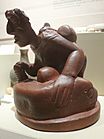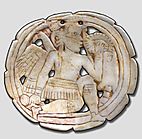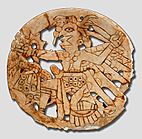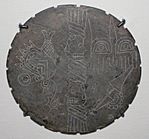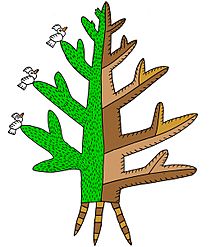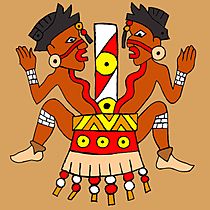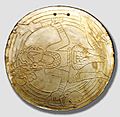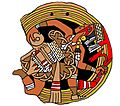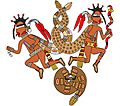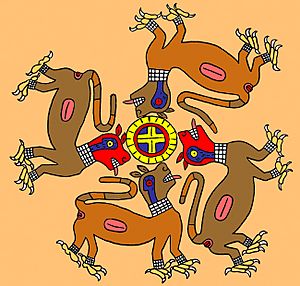Southeastern Ceremonial Complex facts for kids
The Southeastern Ceremonial Complex, also called S.E.C.C., is a name for the similar styles of art, symbols, ceremonies, and stories of the Mississippian culture. This culture existed from about 1200 to 1650 CE. It grew as people started farming maize (corn) and formed complex societies led by chiefs.
Early researchers thought the S.E.C.C. might be connected to cultures in Mesoamerica (like the Maya or Aztecs). This was because both had similar art, grew corn, and built big cities with pyramid-like structures. However, later studies showed that these cultures developed on their own, without direct links.
Contents
Understanding the S.E.C.C.
The S.E.C.C. worked like a big trading network. For example, two similar shell gorgets (decorated pendants) were found far apart. One was in southeast Missouri and the other in Spiro Mounds in Oklahoma. This suggests they might have been made by the same artist or shared across a wide area. Many other similar gorgets link sites all over the Southeast.
The Mississippian culture often focused on warfare. This was shown through many symbols and designs on valuable items. These items were made from materials like conch shells from Florida, copper from the Great Lakes, and lead from Illinois. Pottery from Tennessee and stone tools from Kansas and Texas were also traded.
These special objects were found in important burials. They were buried with war axes, maces, and other weapons. These warrior symbols appeared alongside art showing animals, humans, and legendary creatures. All these symbols connected warfare, their view of the universe, and their noble leaders. Some items were used by chiefs to show their power. The S.E.C.C. was a complex system of religious ideas that helped support the power of local chiefs.
In 1945, archaeologists Antonio Waring and Preston Holder first described the S.E.C.C. They saw it as a specific set of cultural traits. Since then, experts have expanded this idea.
In 1989, scholars like Jon Muller suggested a new way to understand the Mississippian art. He divided the complex into five "horizons," which are like different time periods or stages. Each stage had its own unique symbols, ritual objects, and ways of trading and organizing society.
Mississippian Art Periods
| Periods | Dates | Key Features |
|---|---|---|
| Developmental Cult Period | 900 - 1150 | Long-nosed god masks made of shell and copper appear. The "square cross" symbol also shows up. |
| Southern Cult Period | 1250 - 1350 | This was a peak time for the art. Symbols like bi-lobed arrows, striped poles, maces, and special aprons become common. |
| Attenuated Cult Period | 1350 - 1450 | Trade networks started to break down. Symbols that were once on fancy materials now appeared on everyday pottery. |
| Post Southern Cult Period | 1450 - 1550 | Many different art styles developed in various regions. |
| Historic Period | 1550 onward | The old traditions ended as European people arrived. New tribal societies began to form. |
Because the understanding of the S.E.C.C. grew, some scholars suggested new names. Terms like "Mississippian Ideological Interaction Sphere" (M.I.I.S.) or "Mississippian Art and Ceremonial Complex" (M.A.C.C.) were proposed. Many believe the complex grew from older beliefs that spread across the Midwest and Southeast during the Hopewell Interaction Sphere (100 BCE to 500 CE).
The main style of the complex, called the Braden Style, developed at the Cahokia site. This style matches Muller's Southern Cult Period. Other regional styles formed by mixing ideas from the Braden Style with local traditions.
How Mississippian Art Styles Developed
| Classic Braden Cahokia |
Late Braden Cahokia |
Late Braden | |
| Hemphill Moundville |
|||
| Craig A Spiro |
Craig B Spiro |
Craig C Spiro |
|
| Hightower Etowah |
|||
As major centers like Cahokia declined and trade networks weakened, regional art styles became more different from the Braden Style and from each other. Over time, these local traditions turned into the religious beliefs and stories of the different Native American tribes known when Europeans arrived.
Understanding the Universe (Cosmology)
Most S.E.C.C. art shows ideas about the universe and the special beings living in it. Their view of the universe had three levels:
- The Above World (Overworld): This was home to powerful beings like the Thunderers, the Sun, Moon, and Morning Star (or Red Horn). It represented order and stability.
- The Middle World: This was Earth, where humans lived.
- The Beneath World (Under World): This was a cold, dark place of chaos. It was home to the Underwater Panther and the Corn Mother.
These three worlds were connected by an axis mundi, which means "center of the world." This was often shown as a cedar tree or a striped pole reaching from the Under World to the Over World. Each of these three levels also had its own smaller levels.
A key idea was duality or opposition. The beings from the Upper and Under worlds were always in conflict. Rituals and ceremonies were how people could connect with these powerful forces.
Important Symbols (Motifs)
Many common symbols in S.E.C.C. art helped show where actions took place or where beings came from:
| Symbol | Image | What it Means |
|---|---|---|
| Petaloid Motif |  |
Looks like flower petals but probably shows feathers. When placed around people or objects, it means they are in the "celestial" or sky world. |
| Quincunx or Cross in Circle Motif | Common in many Native American religions. It relates to the sun and often symbolizes the sacred fire on Earth. Combined with the Petaloid Motif, it meant the Above World. | |
| Swastika in Circle Motif | A variation of the Cross in Circle. It symbolizes the creative power of the Underworld. | |
| Forked Eye Surround Motif |  |
Beings with this symbol live in the Above World. It comes from the eye markings of the peregrine falcon. |
| Eye Surround Motif |  |
Beings with this symbol live in the Under World. |
| Ogee Motif |  |
This symbol meant portals (doorways) to the Underworld. It often appears with Under World gods. It might look like caves, or even the markings of a copperhead snake. |
| Striped-Center-Pole Motif |  |
Represents the Axis Mundi or "world tree," the central line connecting all the worlds. It had alternating red and white bands. |
| Trilobed Motif |  |
Looked like a serpent's marking. It might have symbolized a supernatural being's ability to travel between the Lower World and the Upper World. |
| Bi-Lobed Arrow Motif |  |
Often seen on the headwear of warriors or chunkey players. It's a complex symbol that could represent a bow and arrow, a spear-thrower (atlatl), or even a ceremonial pipe. |
| The Hand and Eye Motif |  |
A human hand with an eye in the palm. This was a common symbol, possibly showing a god or a portal to another world. |
| Mace Motif |  |
Usually linked to warriors. It's a drawing of a war club or a ceremonial mace. It might also represent a feather from a powerful spirit bird. |
| Columnella Pendant Motif |  |
A drawing of the central part of a whelk shell. It might be linked to the black drink ceremony, a special ritual. |
The Birdman
The falcon was a very important symbol in the S.E.C.C. It represented warriors and was also prayed to for a long life and healthy family. This supernatural being was believed to come from the Upper World, along with the Sun, Moon, and Four Stars.
The Birdman is often shown on valuable materials like shell or beaten copper. He is usually dancing, wearing large wings and a mask with a raptor (bird of prey) beak. In one hand, he holds a club, ready to strike. In the other, he holds rattles.
At Cahokia, the falcon imagery became very detailed. It was connected to warfare, important games, and possibly the hopes of powerful families to continue their line. The idea of raptors became important during the Hopewell period and reached its peak in the Braden Style of the early Mississippian period. It continued in the Red Horn stories and religions of tribes like the Ho-Chunk and Osage.
In the Braden Style, the Birdman is shown in four main ways:
- Falcon Dancers with wings.
- Chunkey players or warriors with wings.
- Warriors without wings, holding clubs.
- Dancing warriors or chunkey players without wings.
Many symbols are linked to the Birdman, such as the forked eye motif, columnella pendants, maces or clubs, and items from the game of chunkey.
Red Horn and His Sons
The Red Horn stories come from the Ho-Chunk people. These stories are similar to the Maya Hero Twins myths from Mesoamerica. Red Horn had many names, including "Morning Star" because he came from the sky. He was also called "He who is Struck with Deer Lungs," possibly referring to the Bi-Lobed Arrow symbol. In one story, Red Horn turns into an arrow to win a race. After winning, he grows heads on his earlobes and makes his hair into a long red braid. This is how he gets his name "Red Horn."
In another story, Red Horn and his friends play a game (possibly chunkey) against Giants, with their lives on the line. The best Giant player was a woman with long red hair, just like Red Horn's. The little heads on Red Horn's ears made her laugh so much that she couldn't play well, and the Giants lost. The Giants lost all the other games too. Then, they challenged Red Horn and his friends to a wrestling match. All of Red Horn's friends were defeated except for Turtle. Since Red Horn and his friends lost two out of three matches, they were all killed.
Red Horn's two wives were pregnant when he died. Their sons were born with red hair. The older son had heads where his earlobes should be, and the younger one had heads on his chest. These boys brought Red Horn, Storms as He Walks, and Turtle back to life. Because of this brave act, Turtle and Storms as He Walks promised the boys special weapons.
In another part of the story, Red Horn's sons decide to go to war. The older brother asks Storms as He Walks for the Thunderbird War bundle. After some effort, it is given to them. The Thunderbirds ask for a case for the bundle, and a friend of Red Horn's sons offers his own body as its case. The boys take the Thunderbird War bundle and go on a raid to the other side of the sky.
Many S.E.C.C. images seem to show Red Horn, his friends, and his sons. The characters in these stories are closely linked to the pipe ceremony, which was important for family and adoption rituals. The Bi-Lobed Arrow symbol might even be a drawing of the calumet (a ceremonial pipe). Other S.E.C.C. art shows figures with long-nosed god maskettes on their ears.
The Great Serpent
The Great Serpent (or Horned Serpent) is a very famous mythical figure from the S.E.C.C. Its origins go back to the Hopewell times or even earlier. It is usually described as having horns and wings. The wings show its connection to the sky, but they are not always part of its main form.
In some versions of Shawnee myths, the serpent is a multi-headed monster with one green and one red horn. Horns show its power. In other myths, it's a one-eyed buffalo with one green and one red horn. The Piasa figure of the Miami was painted on a cliff near Alton, Illinois. It was described as having the body of a panther, four legs, a human head, a very long tail, and horns.
Mishibizhiw, the Ojibwa underwater panther, was a mix of a rattlesnake, cougar, deer, and hawk. Other Native American peoples also described this being, sometimes called the Spirit Otter.
Where Beliefs Were Found

The Great Serpents were powerful beings from the Underworld. They were always in conflict with the forces of the Upper World, usually shown as the Thunderers (Birdmen or Falcon beings). While people had to be careful of these beings, they could also be a source of great power.
Artifacts Found
S.E.C.C. symbols have been found on many durable materials. These include marine shell, ceramics, chert (like the Duck River cache), carved stone, and copper (like the Wulfing cache and Etowah plates). Many other materials were likely used, but they have not survived over the centuries.
From the remaining artifacts, we can tell that S.E.C.C. people worked with feathers and designs woven into cloth. They also practiced body painting and possibly tattooing, and had pierced ears. A painting found on a clay floor at the Wickliffe Mounds site suggests they painted designs inside and on their homes. Paintings with S.E.C.C. images have also been found in caves, especially Mud Glyph Cave in Tennessee. These paintings show animals, serpents, warriors, winged warriors, horned snakes, stylized birds, maces, and arrows. Their location underground likely connects to Mississippian myths about sacred places beneath the Earth.
| Material | Example 1 | Example 2 | Example 3 | Example 4 | Example 5 |
|---|---|---|---|---|---|
| Engraved Shell | 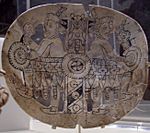 |
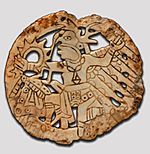 |
 |
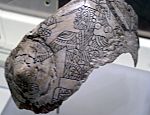 |
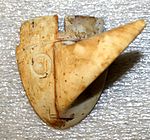 |
| Ceramics (Pottery) | 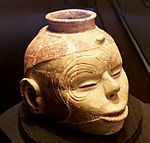 |
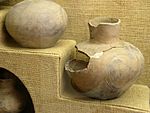 |
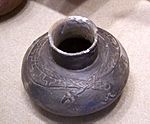 |
 |
|
| Stone | 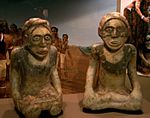 |
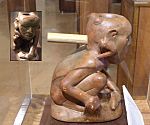 |
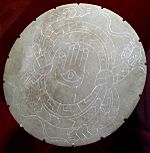 |
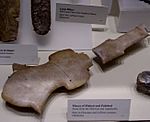 |
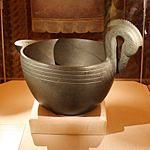 |
| Copper | 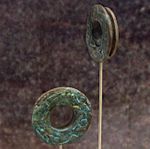 |
 |
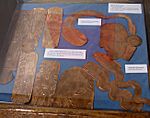 |
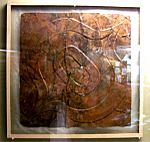 |
 |
Important Sites

- Alligator Effigy Mound
- Angel Mounds
- Cahokia
- Castalian Springs Mound Site
- Etowah Indian Mounds
- Hiwassee Island
- Kincaid Mounds State Historic Site
- Kolomoki Mounds
- Lake Jackson Mounds Archaeological State Park
- Mangum Mound Site
- Moundville Archaeological Site
- Ocmulgee National Monument
- Serpent Mound
- Spiro Mounds
- Town Creek Indian Mound
- Wickliffe Mounds
- Winterville site


